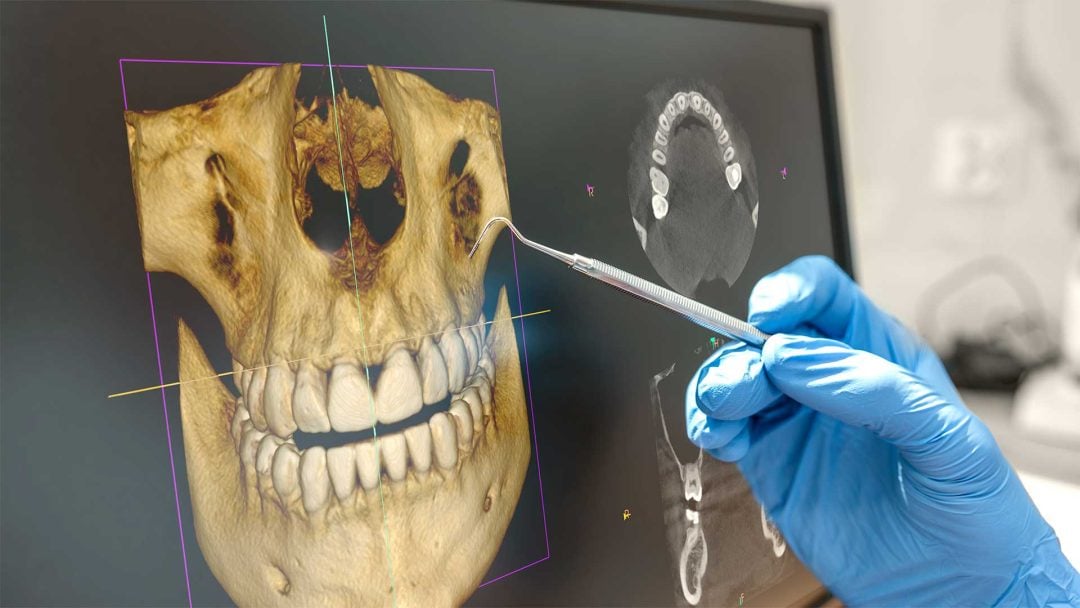Oral Surgery

Oral surgery deals with the surgical treatment of diseases of the oral cavity, teeth, jawbone, hard and soft tissues. Using gentle techniques, we provide minimally invasive surgical solutions for our patients, performing tooth extractions, placing implants, treating jaw infections, and addressing trauma consequences.
In the facial region, the specialty extends to maxillofacial surgery, also known as oral and maxillofacial surgery.
What is Oral Surgery?
Oral surgery, also known as dental surgery, encompasses a broad field of treatment. It fundamentally involves the diagnosis and operative therapy of diseases within the oral cavity. Biological oral surgery extends the traditional scope by supporting natural regeneration and working delicately. Special methods, such as ozone disinfection or A-PRF membranes, create an optimal environment for healthy healing.
How does a Dentist differ from an Oral Surgeon?
A dentist practices general dentistry after completing dental school, covering all aspects of dentistry, including fillings, complex prosthodontic restorations, TMJ therapy, and periodontal treatment. While dentists can perform tooth extractions and surgical procedures, they lack specialized training in this area.
In contrast, an oral surgeon undergoes four additional years of targeted surgical specialization after dental school. Meeting strict training requirements and performing numerous surgical cases are essential. Oral surgeons are specifically trained to handle complex surgical cases and have significantly more surgical experience than dentists.
Topics in Oral Surgery
In the following text, we provide an overview of the wide field of oral surgery. You can gain insight here and explore detailed articles on specific topics through the provided links.
Wisdom Teeth Extraction
Retained or impacted wisdom teeth that lack sufficient space in the jawbone can lead to the penetration of oral bacteria into deep tissues. This can cause pain in the rear jaw, headaches, tension sensations, and, in severe cases, significant swelling or abscesses. Wisdom teeth extraction can gently remove impacted wisdom teeth, addressing the root cause of the problem.
Tooth Extraction
Surgically removing decayed or inflamed teeth is crucial for preserving the jawbone, working with minimal pressure, and creating a healthy foundation for future dental restorations. Fine surgical instruments and knowledge of the correct force application points allow for quick relief from patient discomfort.
Exposure or Removal of Impacted Teeth
Some individuals have teeth that deviate significantly from their normal axes or are deeply embedded in the jawbone, unable to erupt. Infections can result. Using 3D X-rays (CBCT), the precise location of the problematic tooth is determined and exposed for orthodontic incorporation, often involving a small bracket. If this is not possible, the impacted tooth may need to be removed.
Jaw Infections
Jaw pain, elevated inflammatory markers in the blood (e.g., Rantes), or incidental X-ray findings may indicate acute or chronic jaw infections. While a connection to teeth is possible, it is not always necessary. Accurate diagnosis of the cause is essential to treat the infection at its root—either by tooth extraction or localized treatment through a small separate access in the corresponding region.
Surgical Periodontal Therapy
Chronic, deep gum inflammations may require surgical intervention. It may be necessary to detach the gum tissue from the tooth, allowing for thorough cleaning of the tooth surface under direct vision. In some cases, a deeper reattachment of the gum tissue may be the preferred approach, enabling patients to maintain thorough oral hygiene. Hemisections (halving the tooth) or root amputations (removing an inflamed root) may also be necessary in certain situations.
Lip and Tongue Frenulum Correction
Correction of the frenulum of the lip and frenulum of the tongue are very minor procedures and are performed on short or incorrectly positioned frenula. When correcting the labial frenulum, a frenulum that is positioned too low is separated. If it has displaced teeth, these can take their intended place after the correction. This can be the case, for example, with a diastema, a gap between the incisors – by separating the deep-set frenulum, the gap closes by itself.
If a frenulum of the lip or tongue is too tight or shortened and restricts the movement of the tongue, it can be loosened as part of a correction. Here too, a minimal, small incision is made, which heals very quickly.
Traumatology
Injuries (traumatology) resulting from impacts can affect teeth, jawbone, and soft tissues. When a tooth experiences a hard impact, prompt treatment is crucial. Depending on the situation, splinting of the tooth may be necessary. In cases of avulsion (complete loss of the tooth), replantation and splinting are also performed. Alveolar process fractures (fractures of the jawbone) may require splinting, and injuries to the gum, cheek, or lip regions may necessitate suturing for rapid healing.
Cysts / Mucoceles / Cystectomy / Cystostomy
A cyst is a fluid-filled cavity surrounded by epithelial tissue, requiring opening and curettage to prevent expansion. If located in the maxillary sinus (mucocele), complete removal of the process is advisable. While these conditions are not malignant, their rapid growth can displace surrounding bone, significantly weakening it, potentially leading to fractures. In cystectomy, the epithelium of the cyst lumen is entirely removed. In cystostomy, the cyst is made a secondary chamber of the oral cavity. In both cases, the surgeon relieves pressure, allowing the bone to heal.
Bone Augmentation
If considerable time has passed after tooth extraction, or if the extraction was traumatic, jawbone loss may have occurred. For patients opting for fixed dental prostheses (implants), bone augmentation may be advisable either simultaneously during surgery or beforehand. Autogenous bone, synthetic bone, or bone of animal or human origin can be used for this purpose. In our practice, we prefer using autogenous bone whenever possible.
Sinus Lift
Patients often lack bone height in the upper posterior teeth region. The maxillary sinus is anatomically adjacent to the upper teeth, and it can expand, especially after tooth loss. When a patient desires dental implants, a sinus lift may be necessary to reconstruct the vertical height of the jawbone. Internal sinus lifts (access through the implant site or extraction socket) and external sinus lifts (lateral access, requiring more bone) are distinguished.
Dental Implants
Having fixed teeth contributes to quality of life, health, effective food intake, and an aesthetically pleasing appearance. In cases of tooth loss due to caries, infections, trauma, or congenital absence, replacing the missing tooth is essential. A dental implant provides a reliable solution, serving as the foundation for the anatomically correct, individual ceramic crown to be placed later. Implants are an excellent option for comprehensive reconstructions, providing fixed crowns and/or bridges for the entire jaw.
Gum Augmentation
If gum recession occurs due to incorrect brushing techniques, accidents, or overloading, it is possible to rebuild the tissue. Gum tissue can be reconstructed through transplants (from the palate), connective tissue grafts, pedicle flaps, sliding flaps, tunnel techniques, or the envelope technique. We discuss individualized treatment options with our patients in our practice, as the choice of therapy depends on the nature of the defect.
Mouth Tumors / Changes in Oral Mucosa
A tumor in the oral cavity can be benign or malignant, initially describing tissue proliferation without specifying its nature. Diagnosis begins with a clinical examination, determining whether in-practice therapy (e.g., for a fibroma resulting from friction) is possible or if a referral to a maxillofacial surgical clinic is necessary. If you notice changes in your oral mucosa, such as non-healing wounds or discolorations, seek prompt attention from your doctor or dentist. While most are harmless irritations, rare cases may involve dangerous processes, warranting timely diagnosis and treatment.
Apical Surgery (Root Apex Resection)
When inflammation persists in the depth of the jawbone after root canal treatment, traditional oral surgery may involve apical surgery. The gum is displaced, the tooth is shortened, the root apex and the focus of infection are removed, and additional filling from the root apex can be performed. While this technique may allow tooth preservation, we do not employ it in our practice due to potential residual inflammation and limited long-term prognosis, depending on the initial situation.
Methods of Biological Oral Surgery
Biological oral surgery emphasizes a particularly careful approach, using very fine instruments to minimize invasive procedures. Tissues are treated gently to avoid unnecessary trauma, preserving healthy blood supply to bones and gums for optimal healing. Swelling is reduced, and inflammation is avoided to the extent possible.
All wounds are disinfected with ozone, and efforts are made to minimize the use of antibiotics (though specific medical situations may require their use – each case must be assessed individually).
Additionally, the PRF technique by Prof. Choukroun is employed. A small amount of blood is taken before the operation, centrifuged, and the upper portion (platelet-rich fibrin) is introduced into the wound areas. As this procedure uses the patient’s own blood components, including growth factors, white blood cells, and platelets, it optimally supports the healing process.
Dr. med. dent. Josephine Phillips
A minimally invasive and gentle approach to oral surgical procedures is crucial for uncomplicated healing. We are here to assist you with any surgical inquiries.

Frequently asked Questions about Oral Surgery
In the following text, we address the most common questions we receive regarding “Oral Surgery.”
Oral surgery focuses on the surgery of the oral cavity, while maxillofacial surgery encompasses major surgeries, such as complex skull fractures, extensive tumor operations, or surgical positioning of bones in adult orthodontics. A maxillofacial surgeon holds degrees in both medicine and dentistry.
Certainly, we offer treatments in our practice under general anesthesia. We collaborate with an experienced anesthesia team. Feel free to discuss this option with us; it can be a suitable solution for patients with significant dental anxiety or traumatic past experiences.
Minimally invasive surgery aims to traumatize tissues as little as possible. Incisions are small and delicate, treating gums and bones with respect. By avoiding harsh tissue manipulation, swelling is minimal, and healing can occur rapidly. Tissues are preserved and not lost due to the gentle approach.
The need for antibiotics after surgery is determined during the individual examination. We prefer to avoid antibiotics whenever possible, but in certain cases (e.g., after heart surgeries), they may be essential. The patient’s medical condition upon arrival at our practice also plays a significant role in this decision. For example, an abscess may require antibiotic therapy.
Restoring gut flora after antibiotic intake is crucial, and pre- and probiotics can be obtained from your pharmacy or health food store. We are also happy to provide guidance on this matter.
Further Information
Here you will find more information on the topic to gain a deeper understanding.